Abstract
Although the accidental or intentional explosions produced in industrial facilities or in urban areas are events with low probability, they have a high destructive potential and potential for human injuries and/or fatalities. One of the types of such events is given by detonation of improvised explosive devices (IEDs)—dirty bombs for terrorist purposes—which may produce a high number of metallic fragments. Studying mass and spatial distributions of these fragments is useful for evaluating their lethality and destructive potential and may help to implement adequate protective measures. This work brings a closer insight into the fragment dispersion around the detonation of a steel-enclosed C4 charge with cylindrical symmetry. In this respect a specific approach involving both detonation experiments and numerical simulations performed by home-made and commercial software packages for investigation of the fragmentation process and accompanying angular scattering of the fragments was proposed. Special algorithms, which allow the estimation of the spatial distributions of fragments from the numerical analysis of perforations made by the metallic fragments generated by such IEDs on surrounding material walls, are developed. Further, numerical simulations of a similar IED device provided output parameters related to the statistical distributions of mass, kinetic energy and position of the fragments. Experimental fragmentation generated a recovered mass distribution (94 fragments of 67.5 g) that was compared with that extracted from simulation, revealing a reasonable agreement on the 0.3–1 g range. In the case of simulations, 300 fragments from a total number of 374 showed a mass ranging from 0.004 to 0.3 g. The simulations showed that the middle part of the steel case generated fragments of kinetic energy over 4 kJ and its ends generated fragments of kinetic energy under 1 kJ. Experimental fragment scattering distributions were investigated with specific home-made numerical algorithms, which, based on a set of images, analysed the correlations between spatial coordinates of perforations made by fragments on surrounding special panels and provided histograms that are discussed in relation with the fragment-induced lethality degree.
1. Introduction
The explosions produced in industrial or public spaces are events with low probability but with high destructive potential, resulting in high economic costs and human injuries or fatalities. The explosions may be the result of accidents or may also be intentional, such as terrorist attacks. However, experience has shown that even if a building collapse is prevented, a high number of injuries can result from fragments and flying debris. These fragments and debris include the metal fragments resulting from detonation of improvised explosive devices (IEDs)—dirty bombs in terrorist attacks. This risk could be minimised through adequate protective measures. Implementation of such measures requires the study of flying debris involved in explosions. Further, that can lead to a better building design, avoiding specific building materials, detailing and construction techniques.
Two main configurations can be used for IED detonation: (i) uncased or (ii) cased. The open explosive charges can be destructive only through the shock waves generated in the detonation process whereas those enclosed in metallic shells can have a deadly effect at much longer distances due to the spreading of high-velocity fragments.
The mass and initial velocity distributions of fragments resulting from the explosion of a metal-cased charge depend on the detonation energy, intrinsic parameters of the metal, geometry of the metallic shell and location of the detonation point inside the case [,,,,,]. The most studied configuration of the cased explosive devices is the cylindrical one. The mathematical equation providing the velocity of fragments initiated by detonation of a cylindrical metal-cased explosive device has been proposed by R.E. Gurney in 1940. During the detonation process, the metal case undergoes an expansion phase followed by the breakup into fragments with initial velocity given by
where is the velocity, is the mass of the metal case, is the mass of the charge and is the Gurney coefficient (a constant that is specific to a particular explosive). A same initial velocity for all fragments has been considered in the frame of his very simplistic model []. More recent works show a non-uniform velocity distribution of the fragments along the cylinder’s axis [,], sustained by both experimental data and numerical simulations. The tracking of the fragment velocity during experiments was made by flash radiography done with X-ray sources and radiographic films axially placed in the front and the back of the explosive charge []. This technique is not easy implemented, requiring radiological safety rules. Therefore, most of the achievements in this field have been obtained by numerical simulations, which provide the probability distribution of both the mass and the initial velocity of fragments [,]. Recent reports [,] propose new approaches based on Gurney’s model, considering the end effects of the metal case and gas leakage. A theoretical model for velocity distribution in the case of fragments from an asymmetric detonation line of a cylindrical cased charge was also proposed in [].
The fragmentation mechanism of a charged cylindrical case was firstly considered by N. F. Mott [] via a balance between the rate of increasing strains and rate of the relief shock waves leading to cracks formed during the expansion of the metallic cylinder. Accordingly, Mott’s equation that describes the fragment mass distribution is
where is the number of fragments having mass lager than , is the mass of the fragment, is the mass of metal cylinder and is a distribution factor:
where is the specific constant for a given metal–charge pair, is the case thickness and is the inner diameter of the cylinder.
Based on Mott’s model, advances in dynamics of fracture were provided starting in the 1980s by Grady and Kipp [,,,]. A comprehensive review of Mott’s fragmentation could be found in the reference []. The fragmentation process, mainly focused on the cylindrical cased explosive devices, was already studied by different experimental approaches and numerical simulations. A critical issue that appears in the experimental works is related to the difficulty of collecting all fragments after detonation, mainly in the case of soft metallic shells where a large number of small fragments can be generated. To solve this issue, specific experiments were reported in the references [,]. Special working conditions were used during the experiments by placing, around the explosive devices, panels with a sandwich structure formed by two metallic foils with a soft material between them for recording and stopping most of the fragments impacting the panels. The panels were subsequently exposed to intense light to visualise the distribution of the holes drilled by the fragments. The tracked experimental fragments of the cased explosive devices were compared with the ones provided by numerical simulations via Ansys Autodyn or LS-Dyna as usually reported in many papers [,]. It is worth mentioning that the numerical simulations are also very useful in those situations where only a part of the total fragments is collected during the experiments. In these cases, the experimentally obtained mass distributions of fragments can be extrapolated by those generated in simulations.
Based on detonation experiments and numerical simulations, this work intends to bring new insights on lethality effects that an IED with cylindrical shape may generate in the proximity of a detonation place. Special algorithms for analysing the spatial distribution of the perforations generated by metallic fragments on panels placed around the detonation place were developed. The experiments allowed the collection of the metal fragments, with a statistical investigation of their mass distribution and scattering. The numerical simulations allowed tracking the entire process of the case fragmentation, providing output parameters related to the statistical distributions of mass, kinetic energy and position of the fragments, which were further discussed.
2. Materials and Methods
2.1. Experiments
To analyse fragmentation and spatial distribution of the fragments generated by a potential IED, an experiment involving detonation of a small handmade cased explosive device was performed in two approaches. Firstly, this explosive device was built by cutting, from a gas transport pipe (S195T steel grade according to the European standard SR EN 10255 []) with external diameter of 42.4 mm and wall thickness of 3.2 mm, a piece with length of 100 mm, which was filled with C4 explosive. The device detonation was conducted by using an electric detonator based on penthrite. The first approach allows the investigation the fragment mass distribution by placing the device centrally and axially aligned inside a much larger metallic tube with the external diameter of 400 mm the length of 800 mm and wall thickness of 12 mm, which was horizontally positioned in a testing bunker, between two vertical concrete walls (Figure 1). The fragments resulting after detonations (the visible ones) were collected and weighed for statistical determinations.
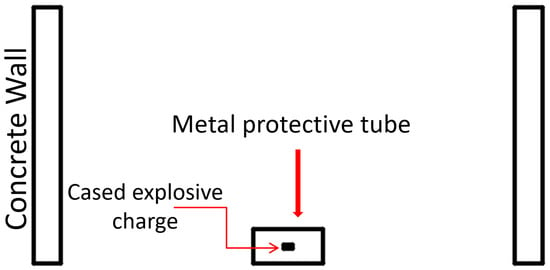
Figure 1.
Experimental setup for detonation of a steel-cased cylindrical charge in a protective metal tube placed between two concrete walls.
In the second approach, three experiments were subsequently performed using similar explosive devices, which were detonated at 500 mm above the ground in front of three panels. In the first two experiments performed with identical explosive devices, the panels were placed at 3 m (exp. 1) and at 2 m (exp. 2) around the explosive device (Figure 2a). In the third experiment, the metal casing was cut according to a pattern similar with that of a grenade (Figure 2b) and the panels were placed at 2 m (exp. 3). Each panel with 100 mm × 200 mm lateral dimensions was built in a sandwich arrangement from three layers: plywood (15 mm thickness), polystyrene (50 mm thickness) and aluminium (1 mm thickness). In this structural arrangement, most of the metal fragments cannot be stopped. Instead, the perforations generated by metal fragments on aluminium foils after detonation were statistically analysed by a novel algorithm relying on imagistic investigations. The proposed algorithm has the advantage of generating specific parameters for future Al-based developments. It can be used in order to create a database that associates explosion-related parameters (involved materials and geometrical configuration) with a set of numerical parameters related to the resulting angular distribution of fragments. The obtained database can be further used for training AI-based algorithms for the identification of an unknown explosion. A set of 2D images from the impact zones is required as input data for the algorithm, which provides a histogram related to the spatial coordinates of the metallic fragments. The obtained spatial distribution probability function (defined by specific parameters such as mean value and standard deviation) is considered the fingerprint of the explosion. The histograms are obtained as follows: (a) input image is converted in grayscale; (b) the origin of the coordinate system is the upper-left corner of each picture of the panel hit by metallic fragments; (c) a predefined threshold value is chosen in order to separate the perforations in the panel; (d) each perforation is uniquely identified using image filling algorithms; (e) the surface and centre of mass for each perforation is computed; (f) distance between each possible pair of perforations is computed and displayed as histogram.

Figure 2.
(a) Experimental setup for detonation of a steel-cased cylindrical charge at 500 mm above the ground in front of three panels; (b) steel casing with grenade-like pattern.
The perforations are of two types: (a) perforations of various areas provided by the direct impact of resulting fragments with aluminium foil and (b) local deformations on aluminium surface, performed by the impact of the fragments reflected by the ground, of much lower kinetic energies.
2.2. Numerical Simulations
In parallel to the experiments, 3D numerical simulations of detonation of a similar explosive device were conducted by using the commercial software Ansys Discovery Simulation 2022 [].
Three-dimensional modelling of the fragmentation process was performed by using the Explicit Dynamics package that allows investigation of dynamic processes carried out in very short time intervals (milliseconds). Hence, impact processes, overpressures or explosions having as results severe deformations or fractures of the materials involved in these processes can be analysed. The advantage of this kind of simulation is given by the possibility of time—tracking all physical parameters that characterise each metal fragment (mass, kinetic energy, scattering angle, etc.).
In a real enclosed charge detonation, the fragments may fly on large distances, even thousands of meters if the blast energy is high. On such distances, air will drastically change the energy and trajectory of fragments. A well-known formula quantifying the drag force of a flying object is
where is air density, is drag coefficient and and are object’s area and velocity. Experiments and simulations have demonstrated that the drag coefficient directly depends on the geometric parameters of the object: shape, size and roughness [,,,,,] and can be experimentally evaluated. Therefore, the fragments generated by a metal enclosed IED are characterised by a wide distribution of drag coefficients and trajectory paths. Large fragments with flat shapes are stronger braked by air than small fragments with sharper geometries. The fragment velocity in air may be written as []
where is the initial velocity of fragments, is the deceleration coefficient and is the traveled distance. The experimental work in [] revealed an average value of 0.009312 for parameter in the case of hypersonic fragments of cylindrical-cone geometry type. That indicates that the velocity reduction in the initial phase of fragment fly path (order of meters) is small and can be considering negligible. Based on an analytic approach, a similar assumption can be found in []. In these circumstances, it is reasonable to assume constant scattering angles of the fragments. Hence, the resulting steel fragments are characterised by linear trajectories and uniform velocities. That gives the possibility to plot their spatial distribution on a cylindrical surface at different distances in the vicinity of the detonation place, together with all the accompanying kinetic parameters. So, a basic estimation of the lethality degree around the detonation place can be calculated, based on the whole set of derived parameters (the density of fragments, their mass and velocity, shape and dimension, incident angle and spin around their centre of mass). However, simulations considering air frictions with hundreds of fragments resulting from detonation of a metal-enclosed charge require a high-power computation hardware configuration, which is not easily accessed. Our 3D simulations run on a low-middle hardware configuration (1 × Intel Xeon processor of 32 cores and 64 GB RAM memory), imposing the condition of excluding air frictional effects.
The input materials used in the numerical modelling were taken from the Ansys library: explosive C4 with corresponding parameters required by the Jones–Wilkins–Lee (JWL) equation of state (Table 1) and Steel 1006 (AISI 1006) for the surrounding metal cylindrical case with corresponding parameters of Mie–Gruneisen equation of state in the frame of Johnson Cook’s dynamic failure model, suitable for ductile metals (Table 2). The steel AISI 1006 is a soft mild steel with a low carbon concentration. It was appreciated that the AISI 1006 is an appropriate material to simulate the metal casing used in the experiments. Further the upper limit of elastic stress (before entering in the plastic deformation regime—Yield Stress) of Steel-1006 (285 MPa), was modified to the value of the steel used in the experimental detonations (195 MPa—from the commercial product specifications). This was the only parameter available in commercial specification. The complete list of parameters of the Mie–Gruneisen equation and Johnson Cook model can be estimated only by experiments involving shock waves and mechanical measurements with special equipment that is not available in our research infrastructure.

Table 1.
C4 explosive parameters corresponding to Jones–Wilkins–Lee equation of state from Ansys library.

Table 2.
Parameters of Steel 1006 corresponding to Mie–Gruneisen equation and Johnson Cook model from Ansys library.
The geometry of the 3D model is shown in Figure 3. An inner cylinder with length of 100 mm and diameter of 36 mm, representing the explosive C4 surrounded by a metallic shell of the same length and external diameter of 42.4 mm, representing the steel case, was considered. The simulated 3D model was virtually positioned at 500 mm above the ground similar to the experiments. The coordinates’ origin of the 3D model was taken at the bottom of the cylinder and the detonation point, marked in Figure 3a by a red ball, was placed at 20 mm below the upper limit of the model, simulating the detonator. The model’s geometry was discretised (Figure 3b) in automatic mode in hexahedral elements with 0.45 mm size to achieve enough elements in the cross-section of the metallic shell thickness (7 elements). Even if the other physical parameters of interest for Steel 1006 are not identical with those of the steel used in the experiment, the scope of the work was attained, being focused on proposing new approaches in the evaluation of fragment scattering distribution generated by metal enclosed IEDs, which can be potential built in a various number of material and geometrical configurations.
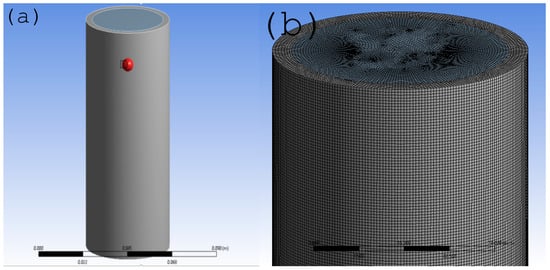
Figure 3.
Ansys Explicit Dynamics model of an improvised explosive device based on a steel cylindrical case filled with C4 explosive. (a) The red ball represents the detonation point. (b) Discretisation of the model geometry.
3. Results
As can be seen in Figure 4a,b, the fragmentation of the steel case, generated from the experimental detonation in the first approach, was powerful enough to result in 96 fragments, which rarely exceeded 3 g in weight (see the mass distribution probability presented by a histogram in Figure 4b). The total mass of the collected fragments was 67.5 g, which represent only 21.7% from the initial metal case mass of 311 g. Two explanations are possible: (i) there were mainly large fragments flowing out of the main steel tube under large angles to far distances (outside to the inspection area) or (ii) there were mainly very small fragments that were pushed out from the tube by the blast wave and became hardly visible by naked eye. However, the second explanation is much more plausible while the simulations detailed below confirm the fact that a large number of small fragments (with mass under 0.25 g) was generated.
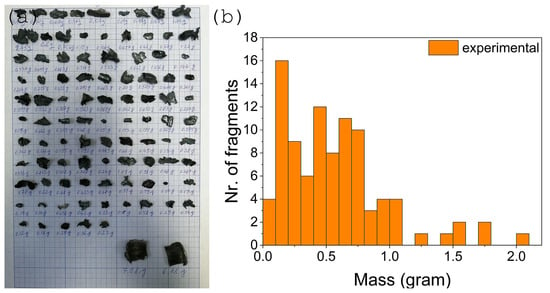
Figure 4.
(a) The collected case fragments after explosion (96 fragments); (b) mass distribution probability of the fragments resulting from detonation of the improvised explosive device.
The 3D simulation ran for s, enough time for fragments’ complete separation. It showed 474 fragments with masses ranging from 0.004 to 5 g (Figure 5a). A full tracking of the fragments’ properties (mass, kinetic energy, initial—before detonation and final coordinates of the fragments, etc.) are shown in the Supplementary Material. The corresponding probability mass distribution is shown in Figure 5b.
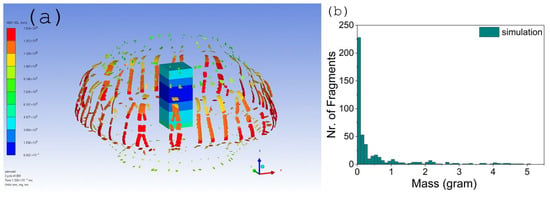
Figure 5.
(a) Ansys modelling of fragmentation process. The legend describes the absolute velocity of fragments in the limits between m/s—blue colour to m/s—red colour; (b) mass distribution of the fragments resulting from Ansys modelling.
Instead of Mott’s formula, the fragment mass distribution can be more properly characterised by a Weibull distribution []:
where is the cumulative number of fragments having masses , is the total number of fragments, is the characteristic mass of fragments and is the shape distribution scale parameter (for , the above distribution goes into a Mott distribution). Figure 6 shows the cumulative number of fragments obtained by simulations (a) and by experiment (b), as fitted by Weilbull-type distributions (continuous line). In the case of the simulation, Weibull distribution parameters were and whereas in the case of the experiment, and . In both cases the fit quality parameter, adjusted R-squared, was higher than 0.986.

Figure 6.
Cumulative fragment number vs. mass generated by (a) simulation and (b) experiment. In red is shown the Weibull distribution function in each case.
As a first observation, the parameter in case of simulation reasonably approaches the specific value for a Mott distribution, as a rough approximation of the fragmentation model. However, this value is much higher than 0.5 in the case of the experiment. While the fragments of low mass give the most important contribution to the fit parameters, this result confirms the hypothesis of losing fragments of very low mass during the collection.
Histograms of both experimental and simulation fragment mass distributions in the same mass range (0.03 to 2 g) are shown in Figure 7. It can be observed that in the range of 0.3–1 g, where more than 65% of fragments were collected, there is no significant difference between collected fragments and those resulting from simulation. On the other hand, in the mass range from 0.03 to 0.3 g the relative number of fragments is much lower in the experimental histogram in comparison to the simulation one, as an additional proof of losing fragments of very low mass during the collection. However, fragmentation of the simulated IED was more powerful than of the experimental IED, where fragments of over 5 g were generated. Similar experiments and simulations proving high fragmentation processes are described in [,,]. Statistical parameters of both experimental and simulation results on fragment mass distribution are presented in Table 3.

Figure 7.
Mass distribution of experimental and simulation fragments on the same mass range (0.03 to 2 g).

Table 3.
Statistical parameters of both experimental and simulated IED fragmentation.
According to the 3D simulation, the kinetic energy () distribution of fragments recorded along the axial dimension (Z axis) of the pipe has two lobes, with the highest in the half of the pipe containing the detonation point (Figure 8). At the ends of the pipe, the kinetic energy is lower, but the density of fragments is higher, as expected due to the loss of the detonation pressure at the ends of the pipe. The middle area of the pipe generates fragments with higher mass and energies, these fragments generating through their dispersion a very high degree of lethality.
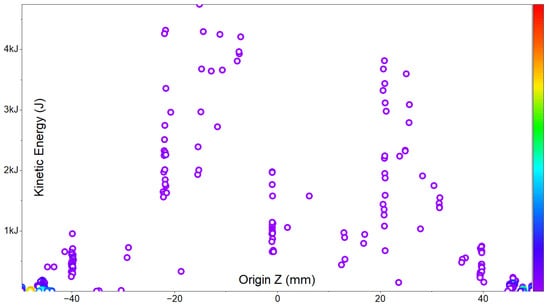
Figure 8.
Two-dimensional representation of the kinetic energy of the fragments with respect to axial dimension of the pipe.
Figure 9a presents the spatial distribution of the initial position and kinetic energies of the mass centres for all resulting fragments. The cylindrical surface is that of the steel case. Considering the initial and final spatial coordinates of the fragments and also the approximation of their constant kinetic energy and scattering angles, the same representation (positions and kinetic energy) is possible for a cylindrical surface of 2 m high with respect to the ground) built up at 2 m distance around the detonation place, as Figure 9b shows.
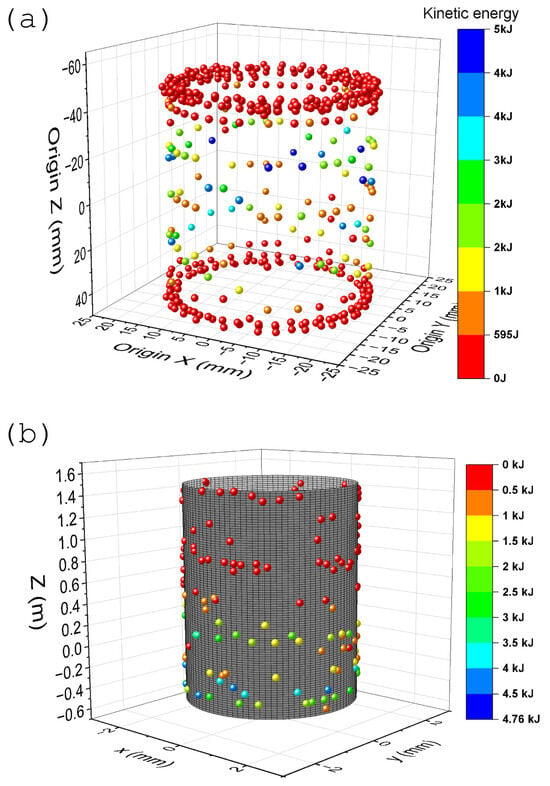
Figure 9.
(a) Initial positions and kinetic energy distribution of the fragments plotted on the cylindrical surface of the steel pipe; (b) the spatial distribution of positions and kinetic energies of the resulting fragments on cylindrical surface of 2 m high with respect to the ground built up at 2 m distance around the detonation place.
The fragment localisation on the experimental panel surface, as observed in Figure 10a, indicates that the density of the perforations is higher at the bottom of the panels. Also, the higher diameter of the perforations located in the same region (bottom of the panel) indicates that the fragments with high mass and energies are scattered at small angles. This is in good agreement with the simulation results presented in Figure 9.
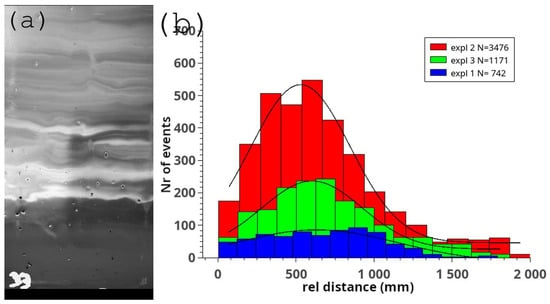
Figure 10.
(a) The image of one of panel hit by fragments; (b) the statistical distribution calculated by the algorithm for fragment scattering.
Quantitative information related to the angular distribution of the fragments was provided by analysing the mutual distances between all pairs of perforations left by fragments on the three panels in Figure 2a. That was performed by numerical processing of each panel image recorded by a camera using a methodology based on a special algorithm implemented in a Python 3 home-designed software.
The methodology involves the fully automatic identification of fragment holes on strategically placed aluminium panels, based on image thresholding followed by flooding algorithms and centre of mass computations. The resulting data are structured in a list containing each hole size and position relative to a fixed origin.
Figure 10b shows the statistical distributions, as obtained by the algorithm, of the computed distances between all pairs of perforations in the case of the three fragment-scattering experiments: (a) , represented by the blue histogram (exp. 1); , represented by the red histogram (exp. 2); and (c) at 2 m with the difference that the metal case was mechanical modelled according to a grenade’s pattern, represented by the green histogram (exp. 3).
The probability function used for fitting the experimental spatial distributions has the formula
where is the area of the distribution; is the double of the standard deviation (); is the mean value of the relative distances with corresponding values in Table 4.

Table 4.
The probability function parameters.
It is defined by specific parameters such as mean value and standard deviation and considered the fingerprint of the explosion. A significant difference in the pair distance across the three experiments is noted. The distribution obtained for the cased (uniform pipe wall) detonation with the panels located at a distance has a sharper profile, indicating a higher impact probability than in the case of panels located at a distance. The most probable relative distance is also higher in the first case (expl. 1) than in the second one (expl. 2), i.e., 360 px vs. 250 px.
Comparing the numerical distributions for the two detonations with panels at 2 m, expl. 2 and expl. 3 (uniform pipe wall and pipe wall with grenade-like patterns), one can observe lower intensity profile of the probability distribution in case of expl. 3, with the maximum kept at almost the same relative distance of about 250 px. The first observation indicates a lower number of recorded perforations on the panel whereas the second indicates almost a similar angular dispersion of the fragments.
Therefore, the only explanation is the formation of a lower number of fragments (due to the pre-engineered patterns of the case) with higher mass and a higher kinetic energy in case of expl. 3.
Models have been created in military research to assess the incapacitating effects of fragment penetration in the human body and estimate fatal and severe injuries, and are based in the probit function []
where is the velocity of fragment in m/s and m is the mass of fragment in kg. The relationship between the probit function and fatality percentages was identified [].
A first lethality effect is given by those fragments that have a high probability of hit in the proximity of the explosion, up to a few tens of meters, but there is a second lethality effect given by those fragments that fly on ballistic trajectories and can hit over long distances.
In the second case, only heavy fragments can cause serious injuries or even death. In Figure 11 the probit function (1) is plotted in the colour scale associated with fragment positions projected on the cylindrical surface in Figure 9b.
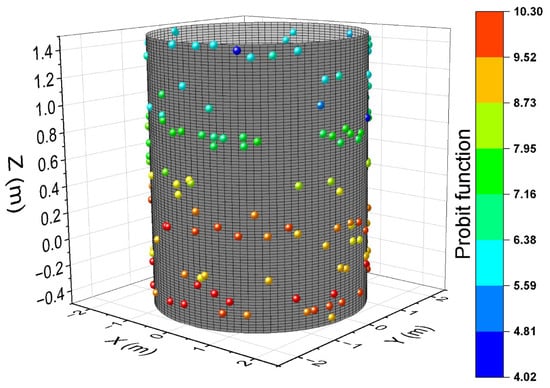
Figure 11.
Probit function values corresponding to fragments with spatial distribution of positions on a cylindrical surface of 2 m high with respect to the ground, built up at 2 m distance around the detonation place.
As the Figure 11 shows, in the vicinity of the ground (between and on Z axis, being the axial centre of the explosive device) most of the fragments have a maximum potential of fatality (<99.9%); they have a mass over . The velocity of all the fragments with a mass over has a constant velocity distribution ranging between 1000 m/s and 1500 m/s.
4. Discussion
A crucial parameter used in the evaluation of a projectile’s lethality is kinetic energy. The 9 × 19 mm calibre bullet has, for example, a kinetic energy around 500–600 J and a 5.56 × 45 mm calibre bullet has around 1.7 kJ. This energy is lost with distance, being strongly dependent on the projectile shape. Along with kinetic energy, projectile shape and size also are determinant factors influencing the lethality degree. It is the case of metal fragments resulting from the detonation of cased charge (grenades, projectiles and IEDs) projectiles, which may cause higher level of tissue damage because of their high kinetic energy and complex motion and, implicitly, trajectories.
The kinetic energy distribution of the metallic fragments generated in the detonation process of a cased IED with cylindrical shape has a two-lobe profile, with maximum kinetic energy reaching up to 4 kJ. This energy depends on a series of factors such as type of explosive and case material and the ratio between explosive mass and case mass.
Similar numerical simulations of steel AISI 1006-enclosed Composition B charge of length 77.8 mm, metal thickness of 3.04 mm and inner radius of 11.8 mm have shown a large velocity distribution from approx. 700 m/s from fragments belonging the cylinder’s ends to more than 1400 m/s for those fragments expelled by the middle part of cylinder []. As in our work, the fragmentation, presented here, is powerful with a wide size distribution of larger elements in the middle part of the case, but the work does not study the mass distribution. This observation can be seen from the 3D simulation pictures. The explosive Composition B is powerful than C4 (8400 m/s with respect to 8000 m/s velocity detonation), but less stable. Another work reported numerical results based on LS-Dyna simulations in the frame of the Johnson–Cook model and Gruneisen equation for an AISI 1045 steel cylindrical case and Jones–Wilkins-Lee (JWL) equation of state for different explosives that filled the steel case []. The work proved the same pattern of fragmentation with larger fragments with higher velocities in the middle part of case than at its ends. Another result of [] indicated that the fragmentation process is strongly dependent on the explosive’s power. Accordingly, for the same steel and dimensions of case, the Composition B charge produced 664 fragments, the TNT charge produced 481 and Al/AP charge produced only 345 fragments. In this paper, the steel case had a length of 77.3 mm, external diameter of 29.68 mm and thickness of 3 mm. The fragments’ velocity reached values over 1400 m/s. Comparison results involving a second steel case of double wall thickness showed smaller velocities that do not exceed 1000 m/s. Along with our results, we can mention other experiments involving detonation of mild steel cylinders filled with aluminised ammonium nitrate explosive, which showed a less powerful fragmentation (fragments of hundreds of grams) []. This is mainly caused by a different steel thickness (from 6–10 mm) in comparison with 3.2 mm in our case, but also another type of explosive was used. The fragments resulting here have higher kinetic energy values than in our case, due to their larger mass, but velocity values were under 1000 m/s. The article also proved that, at the cylinder ends, fragments’ velocities were lower than in the middle part. However, this kind of fragmentation is capable to produce serious damage for civil or critical infrastructure, not only fatal injuries.
Regarding to our work, excepting the fragments originating from the case ends, all the other fragments have enough energy to cause serious damage to a human body. On the other hand, even small fragments of a mass of under 0.5 can cause injuries, especially in the proximal area around the detonation, having at least hundreds of m/s. Sensitive part of body like the eyes or neck are most predictable to be impacted from such fragments. The heavy fragments of masses over 1 gr and, implicitly, high kinetic energies are able to induce severe injuries even at large distances. The injury levels for the same parts of the body are different with respect to the fragment shape and size. Therefore, evaluation of the potential effects of detonation of such metal-enclosed IEDs is a complex work. It involves the estimation of the impact probability of the fragment in the vicinity of detonation and at different larger distances, mainly by experiments (most of the experimental fragment tracking is made in the proximity of detonation) and also of the injury level with respect to the size/shape and kinetic energies of them. In other words, extensive impact experiments and simulations based on human body models are required.
Designing ballistic protective systems for building and industrial/strategical facilities should involve structure models and materials capable of mitigating the kinetic effects of such high-energy metal fragments. Regarding to the damage level that such an event may produce for building or critical infrastructure, and corresponding protection measures, experimental and numerical simulation of impact events of fragments of different geometries and kinetic energies with various materials are also required.
Specific numerical algorithms developed here, which provide impact probability parameters, along with fragment energy distributions resulting from different experiments and simulation scenarios, can be used to evaluate both lethality degree and damage levels that such metal-enclosed IEDs can potentially induce.
5. Conclusions
Explosions in industrial or civil spaces are rare but highly destructive events, that can cause severe damage, economic loss and human casualties, especially in densely populated areas. This work brings new insights in the evaluation strategy of human causalities and possible infrastructural damage as a result of the intentional detonation of metallic-enclosed charges (IEDs). In this regard, this paper is focused on analysing the evaluation on the impact probability of metallic fragment distributions generated by detonation of experimental small IEDs and by numerical simulations. Therefore, experimental detonations were performed, with fragment collection and fragment scattering on special panels, and corresponding numerical simulations using Explicit Dynamics and Autodyn packages of the commercial Ansys program were conducted. The fragments resulting from the detonation experiment were visually collected in a small fraction (21.7%) from the total mass of the steel case, thus agreeing with the simulation that showed a high fraction of (over 60%) fragments with a mass under 0.3 g, difficult to be visually identified. Statistical analyses of both experimental and simulated IED fragmentation and the association between initial localisation of fragments with respect to their kinetic energy and their projection on a cylindrical surface built up at 2 m around the detonation place were performed. Experimental fragmentation was reasonably validated by simulation on the interval of 0.3–1 gr. Simulations showed a powerful fragmentation of the steel case, of about 474 fragments, most of them being generated by the ends of the steel case, which have small kinetic energies (under 1 kJ). In contrast, the fragments generated by the middle part of the case have larger masses and higher kinetic energies (up to 5 kJ), having a large potential lethality. Specific numerical algorithms were developed for analysing the correlations between all pairs of spatial coordinates of the perforations made by scattered fragments on special aluminium–wood sandwich panels. The algorithms use 2D images of the impact area and provide a histogram related to the spatial coordinates of the metallic fragments, characterised by a spatial distribution probability function (defined by specific parameters such as mean value and standard deviation). Each histogram corresponds to the fingerprint of an explosion. Such an analysis could provide criteria for estimation of the potential lethality induced by a fragment dispersion generated in detonation of a metal-enclosed IED. Further, relying on databases provided by these algorithms, efficient AI tools could be implemented for a more accurate lethality prediction. To improve understanding of the effects of such undesirable events and develop adequate protective measures for saving lives and infrastructural elements, there are further required experiments and numerical simulations of various metal-enclosed charge configurations. In addition, studies investigating the impact of different metal fragment distributions with human body models and various materials such as concrete, wood, glass and aluminium are necessary.
6. Patents
A national granted patent could be mentioned here: “Procedure for the automated investigation of characteristic distributions of metallic fragments resulting from explosions”, with registration number A00305 from 2 June 2021 recorded at State Office for Inventions and Trademarks (OSIM) [].
Supplementary Materials
The following supporting information can be downloaded at: https://www.mdpi.com/article/10.3390/app152211851/s1, supplementary: Fragmentation Information Summary.
Author Contributions
Conceptualisation: N.I., A.K. and V.K.; methodology: A.K., N.I., G.S. and P.P.; software: N.I., R.L. and A.K.; validation: A.K., N.I., V.K., G.S., L.R. and P.P.; formal analysis: E.G., A.S., A.K., G.S., P.P., A.N. and A.L.; investigation: A.S., R.L., A.K., G.S., P.P. and A.L.; resources: G.S., P.P. and E.G.; writing—original draft preparation: N.I., A.K. and R.L.; writing—review and editing: V.K., A.K., N.I., P.P., A.S., A.L., G.S., R.L. and L.R.; visualization: G.S., N.I., A.N. and A.K.; supervision: V.K., L.R. and E.G.; funding acquisition: V.K., N.I., G.S., L.R. and A.N. All authors have read and agreed to the published version of the manuscript.
Funding
This research was funded by of the Romanian Ministry of Research and Innovation through the Solutions program, project 33SOL/2021. The authors at NIMP acknowledge also the financial support by the Core Program of the National Institute of Materials Physics, through the Project PC2-PN23080202.
Data Availability Statement
The data that support the findings of this study are available from the corresponding author upon reasonable request.
Acknowledgments
The authors are thankful to Eng. Adelina Ighigeanu for her contribution at mechanical design of experimental IEDs and to the Intervention and Special Actions Service (Romanian Police) for the kind support and assistance with the detonation experiments in a safe environment.
Conflicts of Interest
The authors declare no conflicts of interest.
References
- Wang, L.; Han, F.; Zhou, Q. The projection angles of fragments from a cylindrical casing filled with charge initiated at one end. Int. J. Impact Eng. 2017, 103, 138–148. [Google Scholar] [CrossRef]
- Zhang, Z.; Huang, F.; Cao, Y.; Yan, C.A. A fragments mass distribution scaling relation for fragmenting shells with variable thickness subjected to internal explosive loading. Int. J. Impact Eng. 2018, 120, 79–94. [Google Scholar] [CrossRef]
- Li, Y.; Li, Y.; Wen, Y. Study on fragmentation mechanism under explosion loading. Int. J. Impact Eng. 2017, 99, 947. [Google Scholar]
- Li, Y.; Xiong, S.; Li, X.; Wen, Y. Mechanism of velocity enhancement of asymmetrically two lines initiated warhead. Int. J. Impact Eng. 2018, 122, 161–174. [Google Scholar] [CrossRef]
- An, X.; Dong, Y.; Liu, J.; Tian, C. General formula to calculate the fragment velocity of warheads with hollow core. Int. J. Impact Eng. 2018, 113, 1–8. [Google Scholar] [CrossRef]
- Gold, V.M. Fragmentation model for large L/D (Length over Diameter) explosive fragmentation warheads. Def. Technol. 2017, 13, 300–309. [Google Scholar] [CrossRef]
- Cooper, P.W. Explosive Engineering; Wiley-VCH: New York, NY, USA, 1996. [Google Scholar]
- Grisaro, H.; Dancygier, A.N. Numerical study of velocity distribution of fragments caused by explosion of a cylindrical cased charge. Int. J. Impact Eng. 2015, 86, 1–12. [Google Scholar] [CrossRef]
- Huang, G.; Li, W.; Feng, S. Axial distribution of Fragment Velocities from cylindrical casing under explosive loading. Int. J. Impact Eng. 2015, 76, 20–27. [Google Scholar] [CrossRef]
- Gao, Y.; Zhang, B.; Yan, X.; Zhou, T.; Xiao, X.; Feng, S. Axial distribution of fragment velocities from cylindrical casing with air parts at two ends. Int. J. Impact Eng. 2020, 140, 103535. [Google Scholar] [CrossRef]
- Zhou, M.; Wu, C.; An, F.; Liao, S.; Yuan, X.; Xue, D.; Liu, J. Acceleration Characteristics of Discrete Fragments Generated from Explosively-Driven Cylindrical Metal Shells. Materials 2020, 13, 2066. [Google Scholar] [CrossRef] [PubMed]
- Grisaro, H.Y.; Dancygier, A.N. Spatial mass distribution of fragments striking a protective structure. Int. J. Impact Eng. 2018, 112, 1–14. [Google Scholar] [CrossRef]
- Mott, N.F. Fragmentation of shells under explosive loading. Proc. R. Soc. A 1945, 189, 300–308. [Google Scholar]
- Grady, D.; Kipp, M. Mechanisms of dynamic fragmentation. Factors governing fragment size. Mech. Mater. 1985, 4, 311–320. [Google Scholar] [CrossRef]
- Kipp, M.E.; Grady, D.E.; Swegle, J.W. Numerical and experimental studies of mgh-velocity impact fragmentation. Int. J. Impact Eng. 1993, 14, 427–438. [Google Scholar] [CrossRef]
- Mock, W.; Holt, W.H. Computation of fragment mass distributions for HF-1 steel explosive-filled cylinders. J. Appl. Phys. 1985, 58, 1223–1228. [Google Scholar] [CrossRef]
- Grady, D.E.; Kipp, M.E. Geometric statistics and dynamic fragmentation. J. Appl. Phys. 1985, 58, 1210–1222. [Google Scholar] [CrossRef]
- Grady, D.E. Fragmentation of Rings and Shells; Springer: Berlin/Heidelberg, Germany, 2006. [Google Scholar]
- Arnold, W.; Rottenkolber, E. Fragment mass distribution of metal cased explosive charges. Int. J. Impact Eng. 2008, 35, 1393–1398. [Google Scholar] [CrossRef]
- Xu, H.; Li, W.; Li, W.; Wang, Y. Experimental studies of explosion energy output with different igniter mass. Def. Technol. 2019, 15, 808–814. [Google Scholar] [CrossRef]
- Available online: https://www.union-steels.com/standards/en-10255.html (accessed on 9 September 2025).
- ANSYS, Inc. ANSYS Discover Simulation Software (One-Year Rental License). Available online: https://www.ansys.com (accessed on 9 September 2025).
- Zecevic, B.; Terzic, J.; Catovic, A.; Serdarevic Kadic, S. Characterization of distribution parameters of fragment mass and number for conventional projectiles. In New Trends in Research of Energetic Materials, Czech Republic; NTEM: Hangzhou, China, 2011. [Google Scholar]
- Zhang, F.; He, Y.; Xie, W.; Wei, N.; Li, J.; Wang, S.; Wang, J. Drag coefficients for elongated/flattened irregular particles based on particle resolved direct numerical simulation. Powder Technol. 2023, 418, 118290. [Google Scholar] [CrossRef]
- McCleskey, F. Drag Coefficients for Irregular Fragments; Naval Surface Warfare Center: Washington, DC, USA, 1988; Volume 87. [Google Scholar]
- Li, Y.; Yu, Q.; Gao, S.; Flemming, B.W. Settling velocity and drag coefficient of platy shell fragments. Sedimentology 2020, 67, 2095–2110. [Google Scholar] [CrossRef]
- The Drag Coefficient. Available online: https://www.grc.nasa.gov/www/k-12/VirtualAero/BottleRocket/airplane/dragco.html#:~:text=The%20drag%20coefficient%20contains%20not,the%20object%20and%20the%20flow (accessed on 9 September 2025).
- Shape Effects on Drag. 2024. Available online: https://www1.grc.nasa.gov/beginners-guide-to-aeronautics/shape-effects-on-drag-2/#:~:text=A%20quick%20comparison%20shows%20that,highly%20dependent%20on%20Reynolds%20number (accessed on 9 September 2025).
- Hu, J.; Chen, H.; Yu, Y.; Xue, X.; Feng, Z.; Chen, X. Experimental Study on Motion Law of the Fragment at Hypersonic Speed. Processes 2023, 11, 1078. [Google Scholar] [CrossRef]
- Projectile Motion with Air Resistance. 2011. Available online: https://farside.ph.utexas.edu/teaching/336k/lectures/node29.html (accessed on 9 September 2025).
- Yin, Z.-Y.; Chen, X.-W. Numerical study on the dynamic fracture of explosively driven cylindrical shells. Def. Technol. 2023, 27, 154–168. [Google Scholar] [CrossRef]
- Felix, D.; Colwill, I.; Harris, P. A fast and accurate model for the creation of explosion fragments with improved fragment shape and dimensions. Def. Technol. 2022, 18, 159–169. [Google Scholar] [CrossRef]
- Sweklej, P.; Wasilewski, A.; Magier, M. Radar Method of Measuring the Velocity of the Fragments. Sustainability 2023, 15, 951. [Google Scholar] [CrossRef]
- Kivistik, L.; Mehrparvar, M.; Eerme, M.; Dieves, V.; Majak, J. Numerical modeling of fragment flight dynamics. Proc. Est. Acad. Sci. 2025, 74, 120–125. [Google Scholar] [CrossRef]
- Sielicki, P.W.; Stewart, M.G.; Gajewski, T.; Malendowski, M.; Peksa, P.; Al-Rifaie, H.; Studziński, R.; Sumelka, W. Field Test and Probabilistic Analysis of Irregular Steel Debris Casualty Risks from a Person-Borne Improvised Explosive Device. Def. Technol 2021, 17, 1852–1863. [Google Scholar] [CrossRef]
- A Model for Hazard Assessment of the Explosion of an Explosives Vehicle in a Built-Up Area. Available online: https://apps.dtic.mil/sti/tr/pdf/ADA514151.pdf (accessed on 9 September 2025).
- da Silva, L.A.; Johnson, S.; Critchley, R.; Clements, J.; Norris, K.; Stennett, C. Experimental fragmentation of pipe bombs with varying case thickness. Forensic Sci. Int. 2020, 306, 110034. [Google Scholar] [CrossRef]
- Kuncser, A.C.; Iacob, N.; Kuncser, V.E. Automatic Investigation Method of Characteristic Distributions of Metallic Fragments Resulting from Explosions (Translated from Romanian) RO-BOPI 12, 2022, pg 48. Available online: https://www.osim.ro/images/Publicatii/Inventii/2022/bopi_122022.pdf (accessed on 11 March 2025).
Disclaimer/Publisher’s Note: The statements, opinions and data contained in all publications are solely those of the individual author(s) and contributor(s) and not of MDPI and/or the editor(s). MDPI and/or the editor(s) disclaim responsibility for any injury to people or property resulting from any ideas, methods, instructions or products referred to in the content. |
© 2025 by the authors. Licensee MDPI, Basel, Switzerland. This article is an open access article distributed under the terms and conditions of the Creative Commons Attribution (CC BY) license (https://creativecommons.org/licenses/by/4.0/).